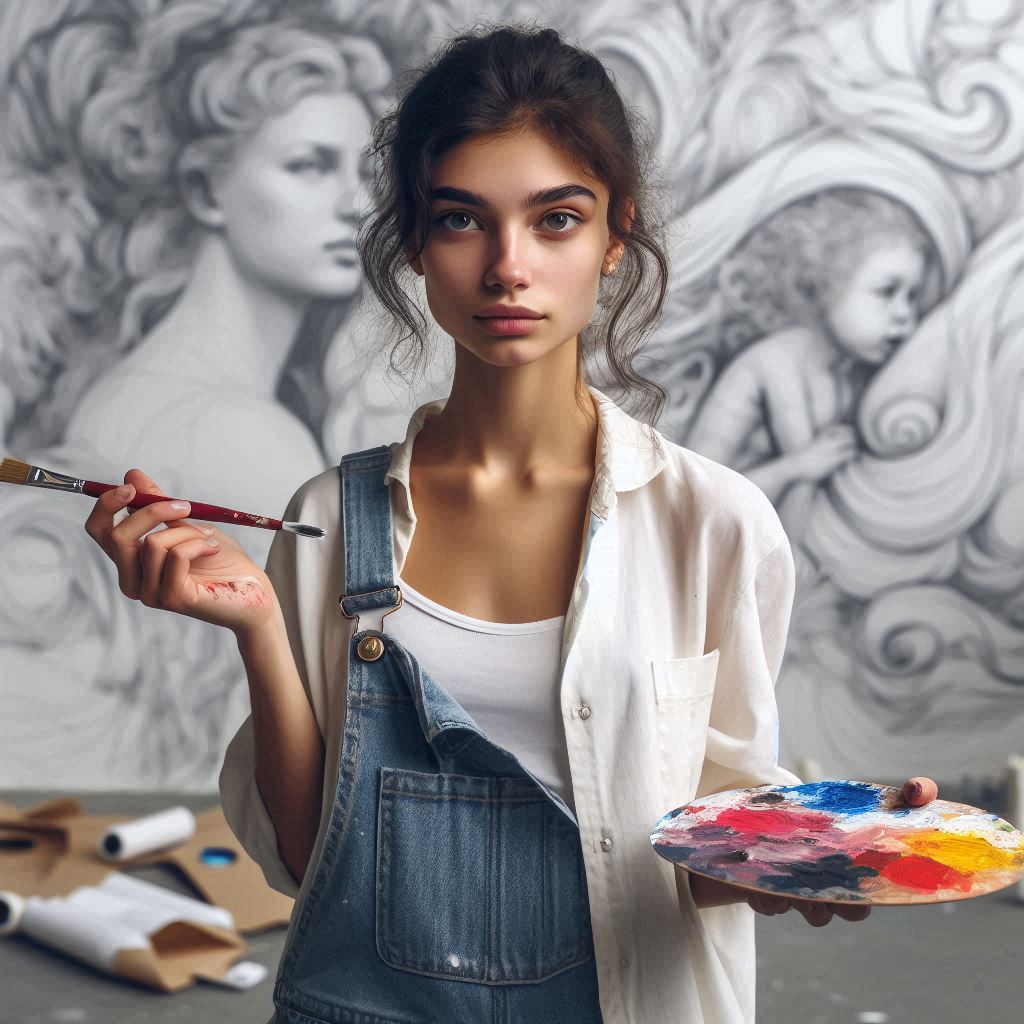Introduction
Mural art and design play a crucial role in the creative industry, transforming public spaces into vibrant masterpieces.
These large-scale artworks are visually impactful, telling stories and adding personality to communities.
The significance of murals extends beyond aesthetic value, often representing cultural, social, and political themes.
As cities embrace artistic expressions, the demand for mural artists and designers has grown rapidly.
Businesses, public institutions, and private clients increasingly seek mural art for unique branding and creative engagement.
Key reasons for the growing demand include:
- Public Spaces: Murals enhance urban environments and attract attention.
- Brand Identity: Companies use murals to create bold, memorable statements.
- Cultural Representation: Communities commission murals to reflect local identity and history.
The creative industry now prioritizes muralists who bring innovation and technical skill to their work.
As this demand continues to rise, it presents a great opportunity for artists to excel in a dynamic and influential field.
Success in mural art and design requires not just talent but also the right skills and adaptability.
Creativity
Creativity plays a crucial role in producing unique and eye-catching mural designs.
Artists who lack creativity may struggle to stand out in a competitive field like mural art and design.
Significance of Creativity
- Uniqueness: Creative thinking allows artists to come up with original ideas that set their work apart from others.
- Attraction: Eye-catching designs draw attention and leave a lasting impression on viewers.
- Innovation: Creativity drives innovation in mural art, pushing artists to experiment with new techniques and styles.
Nurturing and Enhancing Creativity
- Inspiration: Surround yourself with inspiring artwork, nature, or architecture to stimulate creativity.
- Experimentation: Try new tools, materials, and techniques to discover fresh perspectives in your work.
- Collaboration: Working with other artists can spark new ideas and encourage creative growth.
- Break Routine: Step out of your comfort zone and explore different themes or concepts to keep your creativity flowing.
By nurturing and enhancing creativity in mural art and design, artists can elevate their work to new heights and leave a lasting impact on their audience.
Read: How to Price Your Calligraphy and Design Services
Technical Skills
Essential technical skills
- Drawing: This skill is fundamental for creating mural art. Practice sketching to improve precision.
- Painting: Knowledge of color theory and brush techniques is essential for a successful mural.
- Digital design: Familiarity with design software like Adobe Illustrator can enhance your mural projects.
Tips on improving technical skills through practice and learning from experienced artists
- Practice regularly: Dedicate time to drawing, painting, or digital design to sharpen your skills.
- Take classes: Enroll in art workshops or courses to learn from experienced artists and instructors.
- Study different styles: Explore various artistic styles to expand your repertoire and find inspiration.
- Seek feedback: Share your work with peers or mentors to receive constructive criticism and improve.
- Experiment with new tools: Try different materials and techniques to discover what works best for you.
Read: Glass Art and Design: Essential Resources
Knowledge of Materials
When it comes to mural art and design, the choice of materials plays a crucial role in the overall outcome of the artwork.
Understanding the different types of materials, how to use them effectively, and how to maintain them properly is essential for success in this field.
Types of materials used in mural art and design
- Paints: Various types of paints such as acrylic, oil, and spray paints are commonly used in mural art.
Each type of paint has its own unique properties and techniques for application. - Brushes and rollers: Different brushes and rollers are used for creating different textures and effects in mural art.
It is important to have a good understanding of which tools to use for specific purposes. - Stencils and masking tape: Stencils and masking tape are often used in mural art to create precise lines and shapes.
These tools help artists achieve clean and defined edges in their artwork. - Sealants and varnishes: Sealants and varnishes are applied to murals to protect them from weather elements and prolong their longevity.
Understanding how to properly apply and maintain these coatings is essential for the preservation of the artwork.
Importance of understanding how to use and maintain materials
- Quality of work: Using the right materials and knowing how to use them properly can significantly impact the quality of the artwork.
It can result in a more professional-looking mural that stands the test of time. - Durability: Properly maintaining materials such as sealants and varnishes can help protect the mural from fading, peeling, or deteriorating due to exposure to external factors like sunlight and moisture.
- Cost-effectiveness: Understanding how to use materials efficiently can help reduce wastage and unnecessary expenses.
It also ensures that the artist gets the most out of their resources and produces high-quality work. - Safety: Some materials used in mural art can be hazardous if not handled correctly.
Knowledge of proper usage and safety measures can prevent accidents and ensure the well-being of the artist and others involved in the project.
In fact, having knowledge of materials used in mural art and design, along with understanding how to use and maintain them properly, is essential for achieving success in this creative field.
Artists who invest time and effort in mastering the materials they work with are more likely to create impactful and long-lasting murals that resonate with viewers.
Read: Building a Portfolio for Art and Design Careers

Attention to Detail
How paying attention to detail can elevate the quality of mural designs
- Paying attention to detail can elevate the quality of mural designs by ensuring precision.
- Using fine brushes and tools for intricate work can help in capturing details accurately.
- Studying the subject matter closely to replicate textures, shadows, and patterns with precision.
Ways to develop a keen eye for detail through observation and practice
- Developing a keen eye for detail through constant practice and observation of surroundings.
- Attending workshops or courses that focus on honing observational skills and attention to detail.
- Experimenting with different techniques and materials to enhance the level of detail in mural art.
- Researching on various artists known for their attention to detail to gain inspiration and guidance.
Read: Glass Art: Techniques and Innovations
Transform Your Career Today
Unlock a personalized career strategy that drives real results. Get tailored advice and a roadmap designed just for you.
Start NowProject Management Skills
Importance of effective project management in handling mural projects
Effective project management is crucial for handling mural projects.
It ensures that every aspect of the project runs smoothly.
Without proper management, even the most creative ideas can fall apart.
First, project management helps in setting clear goals.
Knowing what you want to achieve keeps the project focused.
It also helps in defining the scope of the project.
This prevents scope creep, which can derail the project.
Second, it aids in resource allocation.
Proper management ensures that you have the right materials and tools.
It also helps in managing the budget effectively.
This prevents overspending and ensures that the project stays within financial limits.
Third, project management is essential for time management.
It helps in creating a realistic timeline.
This ensures that the project is completed on time.
Delays can be costly and can affect the overall quality of the mural.
Fourth, it facilitates communication.
Effective project management ensures that everyone involved is on the same page.
This includes the client, the artists, and any other stakeholders.
Clear communication prevents misunderstandings and ensures that the project meets the client‘s expectations.
Showcase Your Business Today
Reach thousands of readers actively exploring professional services. Publish your business profile and grow your audience now.
Publish NowFifth, it helps in risk management. Every project has potential risks.
Effective management helps in identifying these risks early.
It also helps in developing strategies to mitigate them.
This ensures that the project can proceed smoothly even when challenges arise.
Tips for organizing and planning mural projects from start to finish
Now, let‘s look at some tips for organizing and planning mural projects from start to finish.
- Define the Project Scope: Clearly outline what the project will entail.
This includes the size, style, and theme of the mural. - Create a Timeline: Develop a realistic timeline for the project. Include key milestones and deadlines.
- Budget Planning: Allocate a budget for the project. Ensure that you account for all potential expenses.
- Resource Allocation: Ensure that you have all the necessary materials and tools.
This includes paint, brushes, and scaffolding. - Team Coordination: Assign roles and responsibilities to each team member.
Ensure that everyone knows their tasks. - Risk Management: Identify potential risks and develop strategies to mitigate them.
This includes weather conditions and supply delays. - Regular Updates: Keep all stakeholders informed about the project‘s progress.
Regular updates help in addressing any issues promptly.
Effective project management is the backbone of successful mural projects.
It ensures that the project is completed on time, within budget, and to the client‘s satisfaction.
Collaboration
Significance of teamwork and collaboration in large-scale mural projects
Collaboration is essential for the success of large-scale mural projects.
It ensures that every team member contributes effectively.
Teamwork brings diverse skills and perspectives, enhancing the overall quality of the mural.
Effective collaboration starts with clear communication.
Everyone involved must understand the project‘s goals and vision.
This alignment helps in avoiding misunderstandings and ensures a cohesive final product.
Working with clients is a crucial aspect of collaboration.
Clients provide the initial vision and expectations.
Regular updates and feedback sessions keep them engaged and satisfied.
This ongoing dialogue ensures that the mural meets their expectations.
Team members must also communicate effectively.
Each member should know their specific roles and responsibilities.
This clarity prevents overlaps and ensures efficient use of time and resources.
Stakeholders, such as community members or sponsors, play a significant role.
Engaging them early in the process fosters a sense of ownership.
Their input can provide valuable insights and support.
Effectively communicating and working with clients, team members, and other stakeholders
Here are some tips for effective collaboration in mural projects:
- Hold Regular Meetings: Schedule regular meetings to discuss progress and address any issues.
This keeps everyone on the same page. - Use Collaborative Tools: Utilize tools like project management software to track tasks and deadlines.
This ensures transparency and accountability. - Encourage Open Communication: Foster an environment where team members feel comfortable sharing ideas and concerns.
This openness leads to better problem-solving. - Define Roles Clearly: Clearly outline each team member‘s responsibilities.
This prevents confusion and ensures that tasks are completed efficiently. - Seek Client Feedback: Regularly update clients and seek their feedback.
This ensures that the project aligns with their vision and expectations. - Engage Stakeholders: Involve stakeholders in the planning process.
Their input can enhance the project‘s relevance and impact. - Celebrate Milestones: Acknowledge and celebrate key milestones.
This boosts team morale and keeps everyone motivated.
Effective collaboration is the backbone of successful mural projects.
It ensures that the project runs smoothly and meets the expectations of all involved.
By fostering teamwork and clear communication, you can create stunning murals that resonate with the community.
Explore Further: How to Handle Design Criticism Professionally
Marketing and Promotion
Marketing and promotion play a crucial role in the success of mural art and design services.
Importance of Marketing and Promotion
- Increases visibility and reach to potential clients.
- Establishes credibility and builds trust with clients.
- Generates more leads and business opportunities.
- Helps in distinguishing yourself from competitors.
- Creates a strong brand identity and awareness.
Strategies for Building a Strong Online Presence
- Optimize your website with high-quality images and relevant keywords.
- Utilize social media platforms to showcase your work and engage with followers.
- Start a blog to share insights, inspiration, and behind-the-scenes of your projects.
- Collaborate with influencers or other artists to broaden your audience reach.
- Invest in online advertising to target specific demographics interested in mural art.
Networking with Potential Clients
- Attend art fairs, exhibitions, and networking events to meet potential clients.
- Join online art communities and forums to connect with like-minded individuals.
- Participate in workshops or classes to expand your skills and network with industry professionals.
- Conduct outreach to local businesses, galleries, and organizations who may require mural services.
- Offer free consultations or sample designs to attract new clients and showcase your expertise.
Showcasing Your Work
- Create a professional portfolio showcasing different styles, techniques, and projects.
- Update your portfolio regularly with new projects and testimonials from satisfied clients.
- Publish case studies or success stories to demonstrate the impact of your work.
- Participate in art competitions or exhibitions to gain exposure and recognition.
- Collaborate with interior designers, architects, or event planners to showcase your work in various settings.
Conclusion
To succeed in mural art and design, you need several key skills.
First, creativity allows you to bring unique ideas to life on a large canvas.
Second, technical proficiency in painting techniques ensures clean, professional results.
Third, attention to detail is crucial for handling intricate elements and complex compositions.
Other essential skills include:
- Spatial awareness: Helps you design murals that fit and enhance the physical environment.
- Time management: Allows you to meet deadlines and manage lengthy projects efficiently.
- Collaboration: Working well with clients, teams, or communities is vital for large-scale murals.
Developing these skills will greatly boost your career in mural art and design.
Keep practicing, experimenting with new techniques, and seeking feedback.
Each project is an opportunity to grow as an artist.
By continuing to hone your abilities, you can achieve greater success and recognition in this dynamic field.
Stay motivated, and don‘t hesitate to pursue new opportunities to showcase your evolving talent.
[E-Books for Sale]
The Big Book of 500 High-Paying Jobs in America: Unlock Your Earning Potential
$19.99 • 500 High-Paying Jobs • 330 pages
Explore 500 high-paying jobs in America and learn how to boost your career, earn more, and achieve success!
See All 500 High-Paying Jobs of this E-Book
1001 Professions Without a Degree: High-Paying American Jobs You Can Start Now
$19.99 • 1001 Professions Without a Degree • 174 pages
Discover 1001 high-paying jobs without a degree! Unlock career tips, skills, and success strategies for just $19.99!




